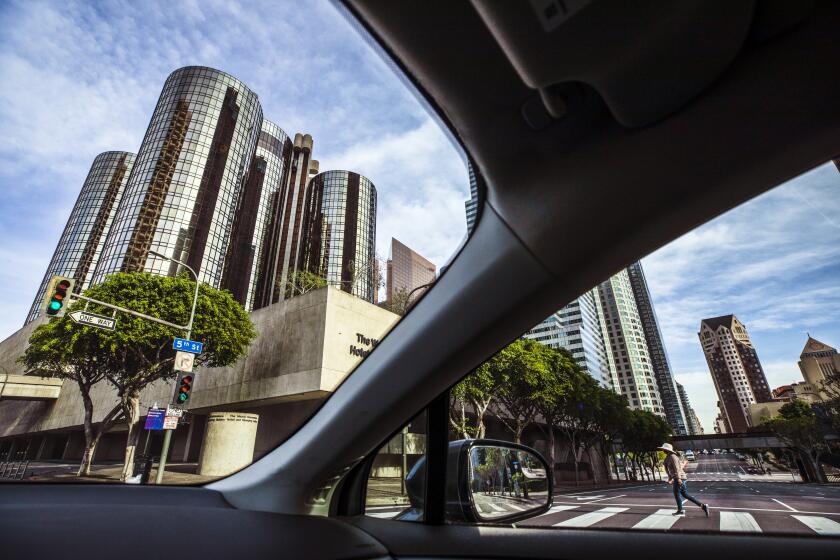Rock Climbing New York Indoor Sport
NEW YORK — The handful of rock climbers who insist on pursuing their obscure sport amid the skyscrapers of Manhattan have decided to do something about the acute shortage of cliffs: They’ve built an indoor climbing wall.
Clambering across a plywood crag may lack the visceral thrills of scaling a 300-foot cliff in Upstate New York or a soaring spire in the Rockies. But the fake wall that opened last month offers climbers a chance to practice most of the basic rock moves.
And more important, it’s close to home.
“It’s great,” said Pierre Vaz, one of about 60 climbers who turned out for opening festivities. “This is a perfect time for it to open, because it’s starting to get nippy outside.”
The wall, in a little-used city recreation center on West 59th Street not far from the Lincoln Center for the Performing Arts, occupies one end of an old paddle-ball court.
Sheets of three-quarter-inch plywood are bolted to the 20-foot-high wall in replicas of the shapes climbers seek in nature: an overhanging cliff face; a narrow chimney; knife-edged arete, or buttress; a two-foot roof jutting out horizontally.
Bolted to the wall are knobby holds cast of sand and plastic resin in a variety of shapes, from easily grasped “buckets” to pockets just big enough to grasp with one finger, to narrow, sloping edges that offer minimum purchase for fingertips or toes.
Protected by safety ropes, climbers puzzle out routes to the top, or move delicately from one side of the wall to the other in that vertical ballet mountaineers call traversing.
Installing the wall was more a political feat than a technical one.
About 18 months ago, climbers who keep their skills sharp by working out on boulders in Central Park found the rangers seemed to be making a special effort to chase them away. Normally a disorganized lot, they formed a loose alliance called the City Climbers Club of New York to lobby park officials to call off the troops.
Organizer Ralph Erenzo says he was pleasantly surprised to find city officials receptive to the new club’s overtures.
They quickly agreed to call off the rangers if the climbers would agree to avoid a few well-traveled spots.
Then, when the climbers mentioned they were worried about twisting their ankles on rocks sticking out of the ground at the base of their favorite 20-foot cliff, “Rat Rock,” the city sent in a backhoe to clear the ground and laid in a layer of shock-absorbing wood chips.
“The club gave us credibility,” said Erenzo, 38, who has a business designing and building exhibits for trade shows. “It showed them we weren’t a bunch of yahoos.”
It turned out that Erenzo’s contact in the park hierarchy was eager to encourage off-beat sports. William Castro, the Parks & Recreation Department’s assistant commissioner for recreation, already had helped organize Frisbee championships, skateboard contests and BMX bicycle exhibitions.
And Castro had dabbled with climbing in an Outward Bound-style confidence-building program the city offers for teen-agers.
“There’s a thrill from it that I don’t think you get in many organized sports--you’re challenging yourself and seeing what you’re made of,” Castro said. “It’s a real test of the individual.”
When Erenzo started talking about artificial walls, the city’s biggest worry was the risk of someone’s falling and filing a lawsuit.
In several months of lobbying, Erenzo showed Castro that artificial climbing walls are becoming increasingly common and sophisticated in Europe, and are slowly coming to this country. The best known is at Snowbird, Utah, where a huge fiberglass scarp was the site of the International Sport Climbing Championships in August.
Erenzo, who has been climbing for a decade and helped judge the Snowbird contest, worked to persuade city officials that his sport is safe if pursued responsibly. The climbers demonstrated how they hang a rope from the top of a practice cliff, so a partner can catch a climber who slips from the rock within a foot or two.
After a slide show by leading French wall designer Jean Marc Blanche, Castro decided to give the idea a try, and offered the sky-lit paddle-ball court in the under-used recreation center.
Everyone involved realizes the wall isn’t accident-proof, but they’ve developed a system to lessen the legal risk.
More to Read
Sign up for The Wild
We’ll help you find the best places to hike, bike and run, as well as the perfect silent spots for meditation and yoga.
You may occasionally receive promotional content from the Los Angeles Times.






